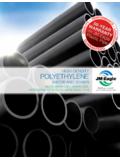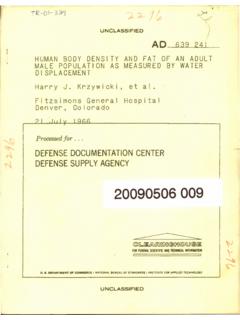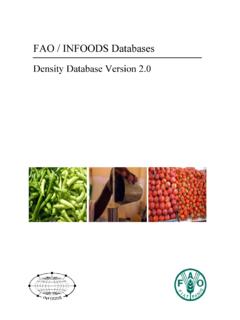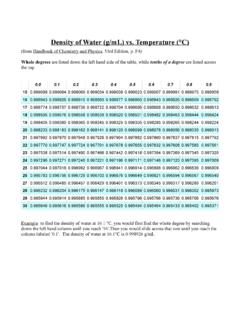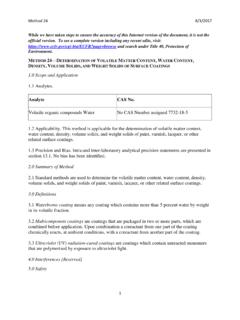Transcription of Chapter 4 Density and Buoyancy - …
1 Chapter 4 Density and BuoyancyWill it float or will it sink? If you are designing ships this is a very important question. The largest ship in the world is the Jahre Viking, an oil-carrying tanker. This super-sized ship is 1,504 feet long and 264 feet wide, longer than 5 football fields laid end-to-end. If the Empire State building was laid on its side, the Jahre Viking would be longer by 253 feet! Crew members use bicycles to get from place to place on the ship. The ship is too large to fit through the Panama or Suez Canal, and it cannot dock in many of the world s seaports. The Jahre Viking is largely constructed of steel so how can a big, heavy ship like this actually float?
2 By the time you finish studying this Chapter on Density and Buoyancy , you will be able to explain how ships and boats of all shapes and sizes can What is Density and how can you measure it?2. What two things does Density depend on?3. How does a steel ship float, when a steel marblesinks?74 UNIT 2 PROPERTIES OF MATTERF igure : The Density of steel, aluminum, water , and air expressed in different - the mass of matter per unit volume; Density is typically expressed in units of grams per milliliter (g/mL), grams per cubic centimeter (g/cm3), or kilograms per cubic meter (kg/m3).
3 Comparative densities(vary with temperature and pressure) DensityWhen you think about the many kinds of matter you come into contact with every day, what properties come to mind? Some matter is solid and hard, like steel and wood. Some matter is liquid like water , or a gas like air. And in the category of solid matter, there are big differences. A block of wood and a block of steel may be the same size but one has a lot more mass than the other. Because of that difference in mass, wood floats in water and steel sinks. Whether an object floats or sinks in water is related to its Density .
4 This Chapter will explain Density , a property of all is a property of matterDensity is massper unit volumeDensity describes how much mass is in a given volume of a material. Steel has high Density ; it contains grams of mass per cubic centimeter. Aluminum, as you well might predict, has a lower Density ; a one-centimeter cube has a mass of only Density ofwater and airLiquids and gases are matter and have Density . The Density of water is about one gram per cubic centimeter. The Density of air is lower, of course much lower. The air in your classroom has a Density of about grams per cubic gAluminum gWater DENSITYCHAPTER 4: Density AND BUOYANCYU nits of densityDensity in unitsof grams permilliliterYour laboratory investigations will typically use Density in units of grams per milliliter (g/mL).
5 The Density of water is one gram per milliliter. That means one milliliter of water has a mass of one gram, and 100 milliliters of water a mass of 100 in g/cm3and kg/m3 Some problems use Density in units of grams per cubic centimeter (g/cm3). Since one milliliter is exactly the same volume as one cubic centimeter, the units of g/cm3 and g/mL are actually the same. For applications using large objects, it is more convenient to use Density in units of kilograms per cubic meter (kg/m3). Table gives the densities of some common substances in both unitsof densityTo convert from one to the other, remember that 1 g/cm3 is equal to 1000 kg/m3.
6 To go from g/cm3 to kg/m3 you multiply by 1,000. For example, the Density of ice is g/cm3. This is the same as 920 kg/m3. To go from kg/m3 to g/cm3 you divide by 1,000. For example, the Density of aluminum is 2,700 kg/m3. Dividing by 1,000 gives a Density of between units of densityA reference book lists the Density of ceramic tile as 2,650 kg/m3. Estimate the mass of one cubic centimeter of Looking for:Mass of 1 cm3, which is the Density in g/cm32. Given: Density of 2,650 kg/m33. Relationships:1 g/cm3 = 1,000 kg/m34. Solution:Divide by 1,000 to get the Density in g/cm3. 2,650 1,000 = gYour A bronze statue has a Density of 6,000 kg/m3.
7 What is the Density in g/mL?Answer: 6 g/mLTable : Densities of common substancesFigure : The densities of some common : The Density range of common (kg/m3) (g/cm3)Platinum21, , , , , , , , , , water1, (wood) (wood) (avg.) 2 PROPERTIES OF MATTERF igure : Follow these steps and you will be able to see a way to the answer most of the problemsA four-steptechniqueThe method for solving problems has four steps. Follow these steps and you will be able to see a way to the answer most of the time and will at least make progress toward the answer almost every time. There is often more than one way to solve a problem.
8 Sometimes you will have to use creativity to work with the given information to find the answer. Figure shows the steps for solving exampleproblems areprovidedThroughout this book you will find example problems that have been solved for you. Following each solved example, there are often practice problems. The answers to the practice problems are provided so that you can check your work while practicing your problem-solving skills. Always remember to write out the steps when you are solving problems on your own. If you make a mistake, you will be able to look at your work and figure out where you went wrong.
9 Here is the format for example problems: PhysicsproblemsProblem solving is important in all careers. For example, financial analysts are expected to look at information about businesses and figure out which companies are succeeding. Doctors collect information about patients and must figure out what is causing pain or an illness. Mechanics gather information about a car and have to figure out how to fix the engine. All these examples use problem-solving densityA wax candle has a volume of 1,000 ml. The candle has a mass of kg (1,400 g). What is the Density of the candle? 1. Looking for:You are asked for the Density .
10 2. Given:You are given the mass and Relationships: Density is mass divided by volume:4. Solution: Density = (1,400 g) (1,000 ml) = DENSITYCHAPTER 4: Density AND BUOYANCYD ensity of common materialsMaterial densityis independentof shapeDensity is a property of material independent of quantity or shape. For example, a steel nail and a steel cube have different amounts of matter and therefore different masses (Figure ). They also have different volumes. However, if you calculate Density by dividing mass by volume, the result is the same for both the nail and the cube. Strong solidstypically havehigher densitySolids that are strong, such as steel, typically have high Density .

